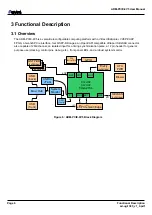
ADM-PCIE-9V5 User Manual
3.7 USB Interface
The FPGA can be configured directly from the USB connection on either the front panel or the rear card edge.
The ADM-PCIE-9V5 utilizes the Digilent USB-JTAG converter box which is supported by the Xilinx software tool
suite. Simply connect a micro-USB AB type cable between the ADM-PCIE-9V5 USB port and a host computer
with Vivado installed. Vivado Hardware Manager will automatically recognize the FPGA and allow you to
configure the FPGA and the SPI configuration Flash memory.
The same USB connector is used to directly access the system monitor system. All voltages, currents,
temperatures, and non-volatile clock configuration settings can be accessed using Alpha Data's avr2util software
at this interface.
Avr2util for Windows and the associated USB driver is downloadable here:
https://support.alpha-data.com/pub/firmware/utilities/windows/
Avr2util for Linux is downloadable here:
https://support.alpha-data.com/pub/firmware/utilities/linux/
Use "avr2util.exe /?" to see all options.
For example "avr2util.exe /usbcom com4 display-sensors" will display all sensor values.
For example "avr2util.exe /usbcom com4 setclknv 1 100000000" will set the MGT_PROGCLK_1 100MHz. setclk
index 0 = MGT_PROGCLK_1, index 1 = MGT_PROGCLK_1, index 2 = MGT_PROGCLK_2, index 3 =
FABRIC_CLK.
Change 'com4' to match the com port number assigned under windows device manager.
3.8 Configuration
There are two main ways of configuring the FPGA on the ADM-PCIE-9V5:
•
From Flash memory, at power-on, as described in
•
Using USB cable connected at either USB port
3.8.1 Configuration From Flash Memory
The FPGA can be automatically configured at power-on from two 1 Gbit QSPI flash memory device configured
as an x8 SPI device (Micron part numbers MT25QU01GBBB8E12-0). These flash devices are typically divided
into two regions of 128 MiByte each, where each region is sufficiently large to hold an uncompressed bitstream
for a VU5P or VU9P FPGA.
The ADM-PCIE-9V5 is shipped with a simple PCIe endpoint bitstream which should be visible to the operating
system (using e.g. Windows Device Manager or “lspci” in Linux) in order to provided confidence that the card is
working correctly when installed in a system. On request, Alpha Data can pre-load custom bitstreams during
production test. Please contact [email protected] in order to discuss this possibility.
It is possible to use Multiboot with a fallback image on this hardware. The master SPI configuration interface and
the Fallback MultiBoot are discussed in detail in Xilinx UG570.
At power-on, the FPGA attempts to configure itself automatically in SPI master mode, depending on the header
of the bitstream that has been flashed into the card. This normally results in SPIx8 configuration at EMCCLK
frequency. The configuration scheme used in the ADM-PCIE-9V5 is compatible with Multiboot; see Xilinx UG570
for details. The FPGA can also be made to reconfigure itself from an arbitrary Flash address using the ICAPE3
primitive; this is also described in Xilinx UG570.
The image loaded can also support tandem PROM or tandem PCIE with field update configuration methods.
These options reduce power-on load times to help meet the PCIe reset timing requirements. Tandem with field
also enables a host system to reconfigure the user FPGA logic without losing the PCIe link, a useful feature
Page 18
Functional Description
ad-ug-1385_v1_0.pdf















































